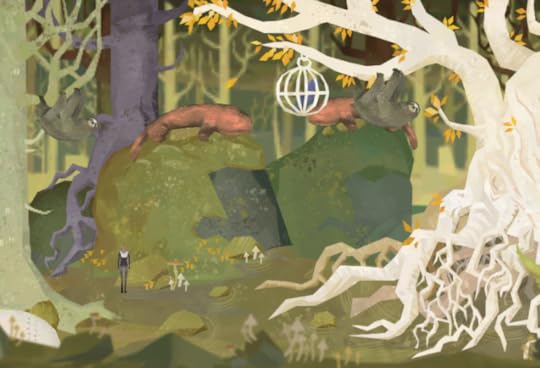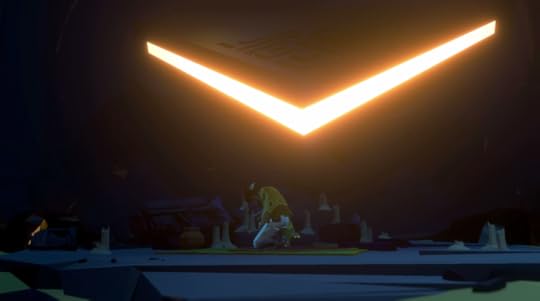Kill Screen Magazine's Blog, page 244
August 7, 2015
Monument Valley studio bring the game's serenity to a mental health app
Anyone who played Monument Valley remembers the feeling of wellbeing that washed over them as they discovered the solution to each puzzle. It's that sense that everything had its proper place; that things fit together and work in harmony. The world, when you manage to see it from the right perspective, simply makes sense. It was the serenity that made Monument Valley such an unforgettable and invaluable experience.
Ustwo, the design studio behind the M.C. Escher-esque mobile gaming masterpiece, teamed up with psychologists to combine the emotional tranquility of Monument Valley with wellness science to create a powerful digital tool. Moodnotes is an app that not only tracks your emotional states with an intuitive and beautiful interface (ustwo's influence), but also uses cognitive behavioral therapy (CBT) to improve your thinking habits.
the app gets to the root of the users thought process
Created in partnership with Thriveport, the app allows users to record their mood with a simple smiley face scale. Ranging between happy and sad, the app registers your input only to then prompt you with questions tailored to your mood. Not having a good day? The app might inquire into whether or not you find yourself getting trapped in a perpetual thinking loop. Enjoying yourself? Moodnotes inquires further to understand how you got there.
Moodnotes wants to help people with their emotional problems by making them more aware of their own patterns. According to what Moodnotes' clinical psychologist Edrick Dorian told Wired,"thinking habits are one of the most important but least taught areas of our well-being." By tapping into your feelings and behaviors, the app gets to the root of the users thought process and helps them identify warning signals for next time. “Much like road signs, you wouldn’t just blast through stop signs and red lights; you’d stop to consider what they’re asking of you," says Dorian. "You can think of feeling states similarly.”
If you're wondering how ustwo could possibly find themselves involved in such clinical work, Nicki Sprinz, the studio's business developer explained to Wired.co.uk. that, "we're all conscious of the impact that stress, anxiety and depression can have on an individual lives, and we wanted to look at a digital solution to help people manage their emotional health. We’re not unique in believing that the current cognitive overload of modern life requires a dedicated outlet, but our solution came in the form of a journal, with psychological advice subtly baked into the experience."
"the current cognitive overload of modern life requires a dedicated outlet"
Thriveport are no strangers to building digital tools that gives results. In 2011, Thriveport released "Mood Kit," a complex emotion tracking app that clinical psychologists would suggest to patients. Moodnotes serves the purpose of streamlining that experience and tailoring it to more general mood issues like anxiety and stress rather than more serious forms of mental illness.
You can check out Moodnotes for yourself for $3.99 here.
On the much hated and woefully overlooked codec radio
The invincible and memorable conversations of Snake.
New game about sketches mirrors a classic Looney Tunes episode
Have you ever been watching a cartoon when suddenly the screen goes white, the main character is standing there alone, and the animator’s pencil drops down into screen to mess with the world? It’s a classic fourth-wall-breaking gag that’s all over the place in animation—from the classic Looney Tunes short Duck Amuck to the more recent Animator vs Animation series of viral videos—and now it’s coming to games.
an unfinished sketch looking to discover what it was meant to be
Usually, this trope is played for comedy, but new 3D platforming game Unfinished - An Artist’s Lament seeks to use it for existential drama. Casting you as an unfinished sketch looking to discover what it was meant to be, Unfinished tasks you with following your creator’s pencil to learn more about his art. Along the way, you’ll have to collect other unfinished sketches that allow you to jump, run, and fly as you follow your creator, observe his newest creations, and listen to him struggle to complete his work. By the end, you’ll have learned more about not only the sketch you’ve been playing as, but also the artist who drew you.
Boasting artwork from over 25 different artists and a hybrid art style that pairs 2D animation with a 3D environment, Unfinished is currently available on Steam for PC, Mac, and Linux.

Dan Pinchbeck on rapture, religion, and ���The Chinese Room��� feel
The Everybody’s Gone to the Rapture designer opens up.
August 6, 2015
Find peace by gardening the harmonious landscapes of Barmark
Sign up to receive each week's Playlist e-mail here!
Also check out our full, interactive Playlist section.
Barmark (Android)
BY Stormhatt Studios
The characters in Barmark are all damaged in some way. You can see this as they wander the rigidly-cut pastoral landscapes guided by your finger. They are searching for harmony (which is believed to have healing properties), and to find it, you need to help them shape the environment to a pleasing arrangement. To this end, you can plant trees and flowers, but the idea is to seek out hidden ancient machines that can enact dramatic changes on the quiet forests, snowy hills, and stony banks. On each playthrough, two Archanimals will be chosen at random that ask for specific changes, but you don't have to listen to them. There is no death, no right and wrong, as Barmark is intended only for you "to achieve harmony and personal perfection."
Perfect for: Explorers, gardeners, idealists
Playtime: As long as it takes to heal

The freedom of being a bird girl isn't without its dangers
A blue sky riddled with floating islands, purple deer, and idyllic waterfalls—the opening scene of Aer’s trailer is a scenic glance at an abstract cubist-esque world. The expanse hovering before us is at peace, but we know that there’s so much more to see. Taking in the view with us is Auk, a pilgrim girl who, after turning to look at us, dives off the edge head-first and transforms into a skybird with a spin and a flurry of light.
The bird is reminiscent of The Legend of Zelda: Skyward Sword’s loftwings, but this world seems like so much more than Skyloft. The orange bird ducks below fractured Eden-like islands, through the storming broken pieces of a frozen tundra, close enough to the airborne landscapes to skim them as she passes. The trailer reminds us what Aer is really about: exploration of a lingering world, splintered and unknown. It’s a thrilling mix of fear, as Auk leaps with the wind beneath her, and the delightful promise of basking in someplace new.
When Auk lands on the grass before a cave, her bird form dwindling away with the wind, she approaches something not yet featured in the trailer throughout all her adventures; pitch black darkness. The whimsical music fades into an eerie hum as Auk passes the carved stone slabs littering the entrance of the cave and looks at the walls around her with wonder. Whereas her steps once seemed confident and sure, they now seem layered with hesitation. The invigoration of something new is tempered with the intimidation that comes with the unknown.
the delightful promise of basking in someplace new.
Auk approaches a glowing shrine deep within the cavern. Hovering through the air in the shrine’s clearing are floating flakes of snow—or is it ash? A tall statue of a woman holds out a glowing treasure and our protagonist accepts it. Immediately, from the darkness behind the shrine, a stone beast rears it’s head, and the shrine collapses before Auk, who falters to the floor, alone and afraid. With a roar, the lights go out and the screen fades to black, leaving only the eyes of the massive beast. Suddenly, even after witnessing the world with a bird’s-eye-view, we are left feeling smaller than ever.

But, just as we’re reminded of the world’s darkness, we get a glimpse of the light. Auk rises from the ground, the artifact in her arms glowing once more, to find herself surrounded by dozens of shining blue beings. The fear has passed and the wonder can take its place once more, leaving us more excited to explore than ever before.
Aer will be coming to PlayStation 4, Xbox One, and PC in 2016. You can track its development on its website.
August 5, 2015
We'll Meet Again takes collaborative gaming offline
The Ear Force PX51 is a lot of headset—$296.95 worth of headset, to be precise. It is billed as an “advanced gaming audio system.” It comes with many features that are prefixed with “dual-”, which makes sense insofar as most people have two ears. All of that is a complicated way of saying the PX51 allows you to hear what is happening in a game and communicate with others, all for the princely sum of $296.95. That’s nice, I guess, but what if you wanted to play a game and talk to someone else with slightly less technological intermediation?
We’ll Meet Again, which was created by Claudia Molinari & Matteo Pozzi (aka We Are Müesli) for Milan’s Global Game Jam 2015, offers just that mix between digital gaming and direct human interaction. Two players sit facing each other, with computers in front of them. The configuration is reminiscent of the plastic board game Battle Ship. Both players have downloaded We’ll Meet Again. The first player opens “Side A,” and uses it to explain what the other player is seeing on their screen. The player with “Side B” uses these hints to select—and listen to “vinyls.” The two players trade information until they have solved the game’s five levels and reached a happy ending.
the crucial connection is human.
Whereas the PX51 exists to argue that gamers are connected by miles of cable running under oceans and through mountains, We’ll Meet Again suggests that the crucial connection is human. In fact, the two computers used in We’ll Meet Again don’t need to be connected to one another during gameplay. There is technology at play here but it is in a subordinate position. You are not being worn by an expensive “advanced gaming audio system.” Of all the human touches in We’ll Meet Again, that fact is the most reassuring.
You can download We'll Meet Again on itch.io.
Hands on with Jotun, the happiest game about Viking warriors ever
Jotun is shaping up to be equal parts The Black Cauldron and Shadow of the Colossus.
Everybody���s Gone to the Rapture���s launch trailer reveals nothing
The launch trailer for Everybody’s Gone to the Rapture, an exploration game that juxtaposes the mundanity of human lives with the apocalypse, has been released. While it’s clear the game focuses on the few left behind after most other people have gone missing, the cause of the tragedy is unclear.
perhaps this was not god but humans trying to play god
The video juxtaposes religious and secular overtones. It begins with a recording of an astrophysicist declaring, “It’s over. I’m the only one left,” before a moving light draws our attention to the places there should be people. There’s been no sign of a struggle; there are simply abandoned tasks. The sequence ends in a church, zooming across pews, each with their own lights, to focus on the altar before fading.
Even as scientists declare it’s their fault and argue as to whether they’ll be able to stop it, hymns persist behind them. The couple of survivors argue about their safety and lights travel over quiet night scenes to highlight who’s been lost. The religious iconography of the game is undeniable and ever-present, but the inclusion of research even down to the site teasing us with interviews and journal abstracts suggests that perhaps this was not god but humans trying to play god, and, regardless, perhaps it can be reversed.
Everybody’s Gone to the Rapture releases for PS4 on August 11.
The alluring deathscapes of Feist
After the better part of a decade of development, Feist comes out to kill you.
Kill Screen Magazine's Blog
- Kill Screen Magazine's profile
- 4 followers



